Welcome to the landscape photography blog by Chuck Derus. Thanks for looking and for your comments!
Welcome to Coldfoot
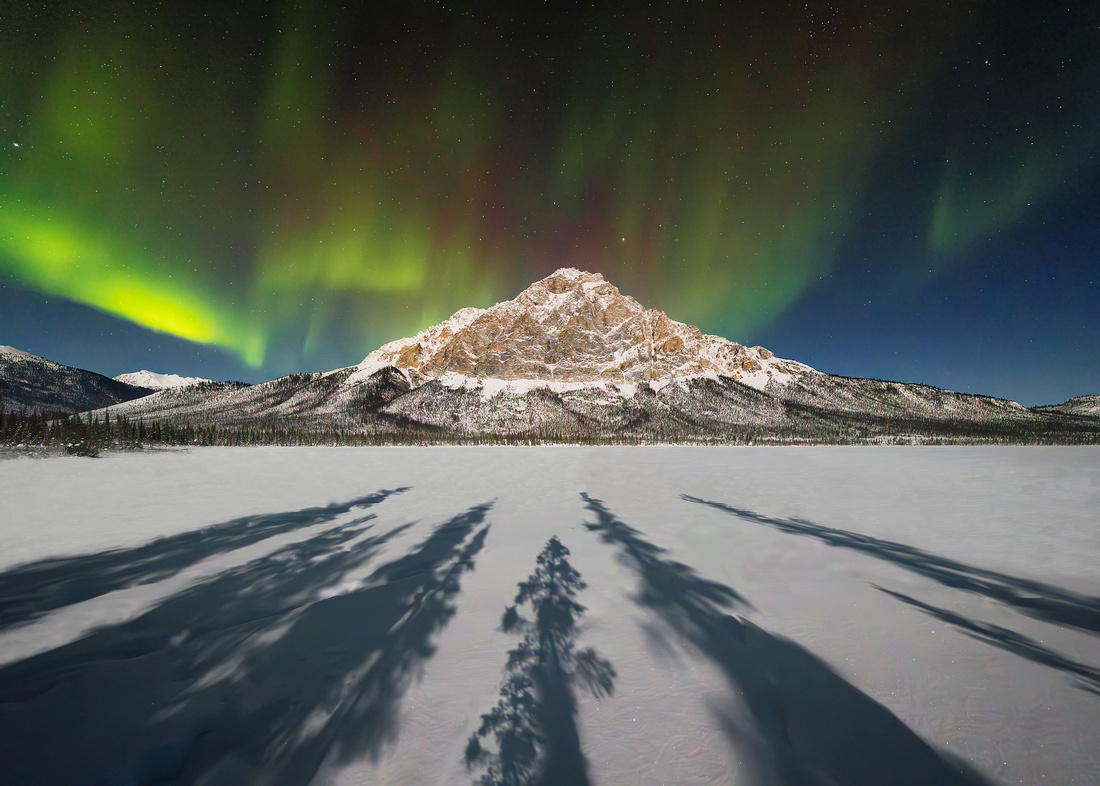

What a name! Coldfoot, Alaska (population 34) is aptly named. The lowest unofficial recorded temperature there was a chilly -82 degrees Fahrenheit!
The town began as an 1899 gold mining camp named Slate Creek. Folklore has it that the current name was derived from gold rush prospectors getting "cold feet" about making the 240-mile journey further north to Deadhorse.
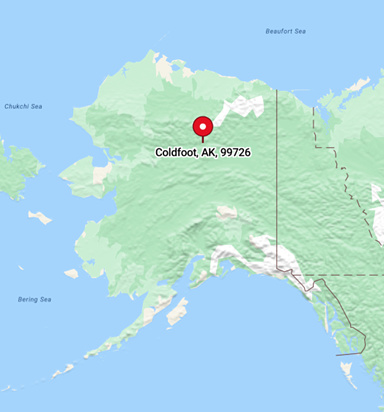

The town languished until the 1970s when the Alaska Pipeline was built. Now it’s a rest stop on the Dalton Highway for ice road truckers heading to the oil fields on Alaska’s northern coast.
The town consists of a truck stop, a motley collection of old-school gas pumps, a hotel, a trooper’s office, an Alaskan Department of Transportation office, post office, and a runway for bush planes.
The Coldfoot Camp truck stop was founded by Iditarod champion Dick Mackey. He started his operation selling burgers out of a converted school bus. Truckers then helped build the truck stop and cafe.


The Coldfoot Camp Trucker’s Café menu.
The hotel rooms are spartan former pipeline worker trailers. But the hotel is the best (and only) hotel in town, so I paid the $300 per night price and enjoyed the experience!
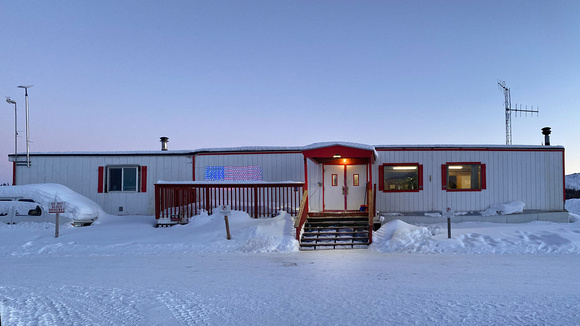

The hotel.
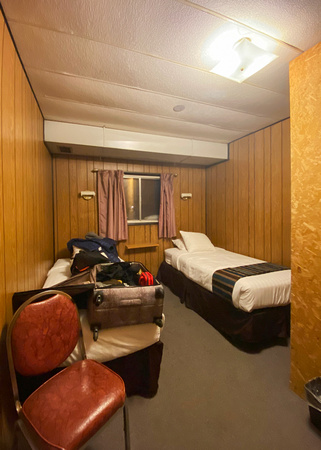

Heat, hot water, a shower, and electricity!
The Shot
Our photography group left Coldfoot on the evening of February 16 in search of the Aurora Borealis. After driving about an hour North, we stopped at the Dietrich River bridge and headed to a location we scouted that afternoon.
But the foreground and the anticipated location of the Aurora didn’t seem quite right. So, we piled into the car and relocated further upriver. We had to trudge about 100 yards in knee deep snow after we stopped at a nearby frozen lake.
Our reward was a pattern of strong leading lines created by tree shadows aimed at a mountain peak across a frozen lake. Now we just had to wait.
Our patience was rewarded when the light show began. We didn’t even notice or care that it was a chilly -11 degrees out. Nature’s beauty mesmerized us. After about three hours, the show stopped, and we headed for the warmth of our unique hotel rooms.
Thanks for looking,
Chuck Derus
To Dwell on and Remember
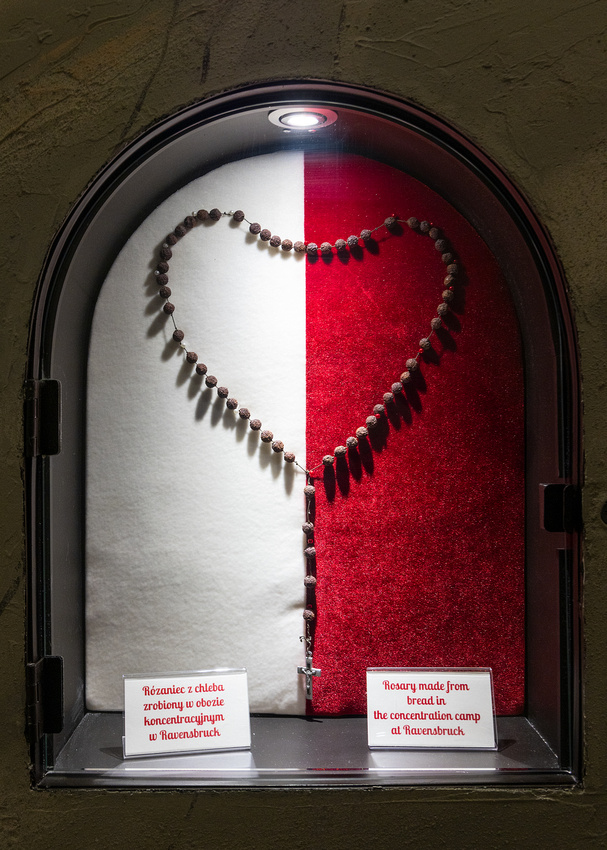

The morning of January 20 began in a joyous, beautiful, and blessed place. I was at Holy Trinity Polish Catholic Church in the Pulaski Park neighborhood of Chicago. The occasion was a photo tour of this historic church. The tour ended on a somber note.
The church, completed in 1906, is a blend of several architectural styles. This blending is reminiscent of Poland’s Middle Ages churches. As churches sustained damage by war or fire, they were rebuilt and remodeled in a multitude of styles. The architect evidently hoped to remind the Holy Trinity parishioners of churches from the old country.
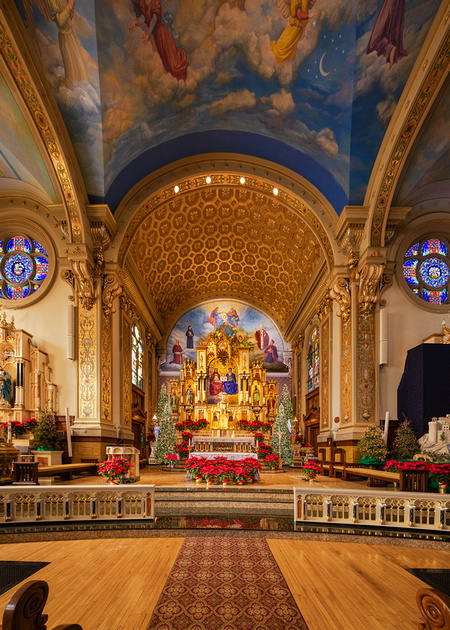

Christmas decorations in the Polish tradition go up on December 24 and come down February 2nd on Candlemas.
For over a half century, Holy Trinity was the center of activities for its 60,000 parishioners. Everything you could possibly want was available at church or in the square mile that it served. In 1960, when the Kennedy Expressway cut through the heart of Chicago’s Polonia, the neighborhood and parish slowly declined as Poles moved to the suburbs.
Mass is celebrated strictly in the Polish language. In honor of its 100th anniversary, the congregation began a renovation campaign in 2005. Today, the church’s many features are beautifully restored.


Part of the ceiling
Catacombs
During construction, pastor Casimir Sztuczko CSC wanted to set aside an area to venerate the holy relics of saints and the beatified. The result is one of the most distinctive and interesting aspects of Holy Trinity, the so-called Catacombs.
Located in the basement, it consists of a winding path lined with niches containing saintly relics leading up to a chamber containing the grave of Christ. There are now 267 relics in the catacomb.


Part of the Catacombs
The Shot
One heart-wrenching relic commanded my attention. I was looking at a rosary made from bits of bread at Germany’s Ravensbrück concentration camp.
Ravensbrück was a Nazi concentration camp in northern Germany exclusively for women from 1939 to 1945. An estimated 132,000 women passed through the camp during the war. Many of them were slaves working under unspeakable conditions for the Siemens & Halske company. Among other things, Siemens produced field telephones of the type "Feldfernsprecher 33."
About 48,500 women were from Poland. Fifteen percent of the prisoners were Jewish, with eighty-five percent from other races and cultures. Almost half of all prisoners died at Ravensbrück. The majority perished from disease, starvation, overwork, and despair. About 2,200 were gassed.
Hoping they might survive; Polish Catholic prisoners made rosaries from their skimpy bread rations and hid them. Discovery meant death. The homemade rosary on display had been soaked in the blood of a Polish mother and daughter killed at Ravensbrück.
My thoughts were jolted back to the November 10, 1961, episode of The Twilight Zone. In the episode Deaths-Head Revisited about a concentration camp commandant, Rod Serling ended with this powerful outro.
“All the Dachaus must remain standing. The Dachaus, the Belsens, the Buchenwalds, the Auschwitzes; all of them. They must remain standing because they are a monument to a moment in time when some men decided to turn the Earth into a graveyard. Into it they shoveled all their reason, their logic, their knowledge, but worst of all, their conscience. And the moment we forget this, the moment we cease to be haunted by its remembrance, then we become the gravediggers. Something to dwell on and to remember, not only in the Twilight Zone but wherever men walk God's Earth.”
Lest we forget,
Chuck Derus
Ladyfinger #2


Last week’s blog was about compositions that use a frame within a frame. This is a second composition framing Ladyfinger using a pair of trees. Let me know if you prefer the horizontal photograph from last week or this week’s vertical composition.
Driving Through Pakistan
We drove every day during our thirteen days in Pakistan’s Hunza Valley. Delays were not uncommon. 😊
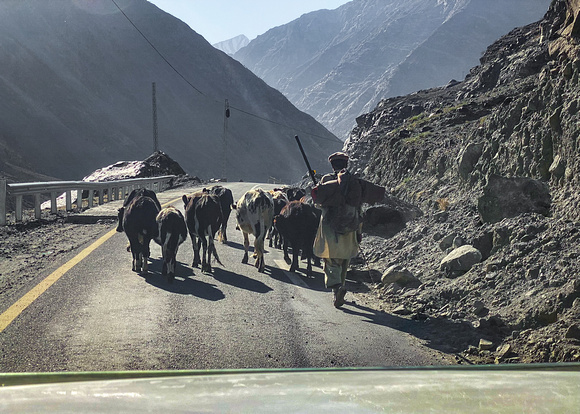

Scores of children walking, laughing, and talking while walking to and from school were a ubiquitous sight. There were no parents dropping off their kids at school. Walking several miles up and down thousands of vertical feet was common.
Our expedition leader, Muqeem Baig (Climax Adventure Pakistan | (climaxadventurepk.com)) commented that the literacy rate of Hunza Valley is above 95 percent. And all children have access to a high school education.


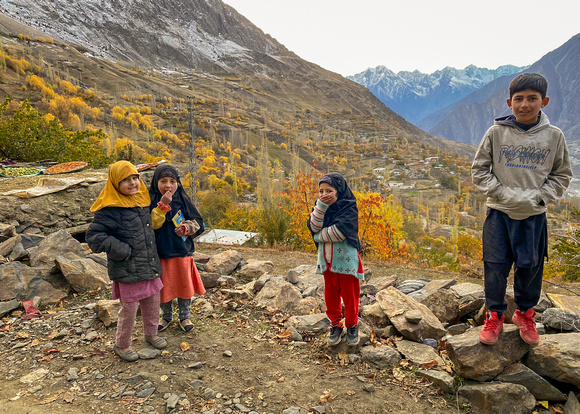



A few of the schoolchildren we met in villages walking to and from class.
Government school is only $2 US dollars a month. Private schools are substantially more, up to $200 a month.
The Shot
It was early on the morning of November 7 when we arrived at our Ladyfinger viewpoint. The Peak was about 5.5 miles away in the distance. We had sufficient time to scout several possible compositions.
This composition really seemed to place Ladyfinger in a frame within the two-dimensional frame of my photograph. Ladyfinger is in the left center, with nearby Hunza Peak at 20,570 feet on the right.
Thanks for looking,
Chuck Derus
The Lady in Waiting
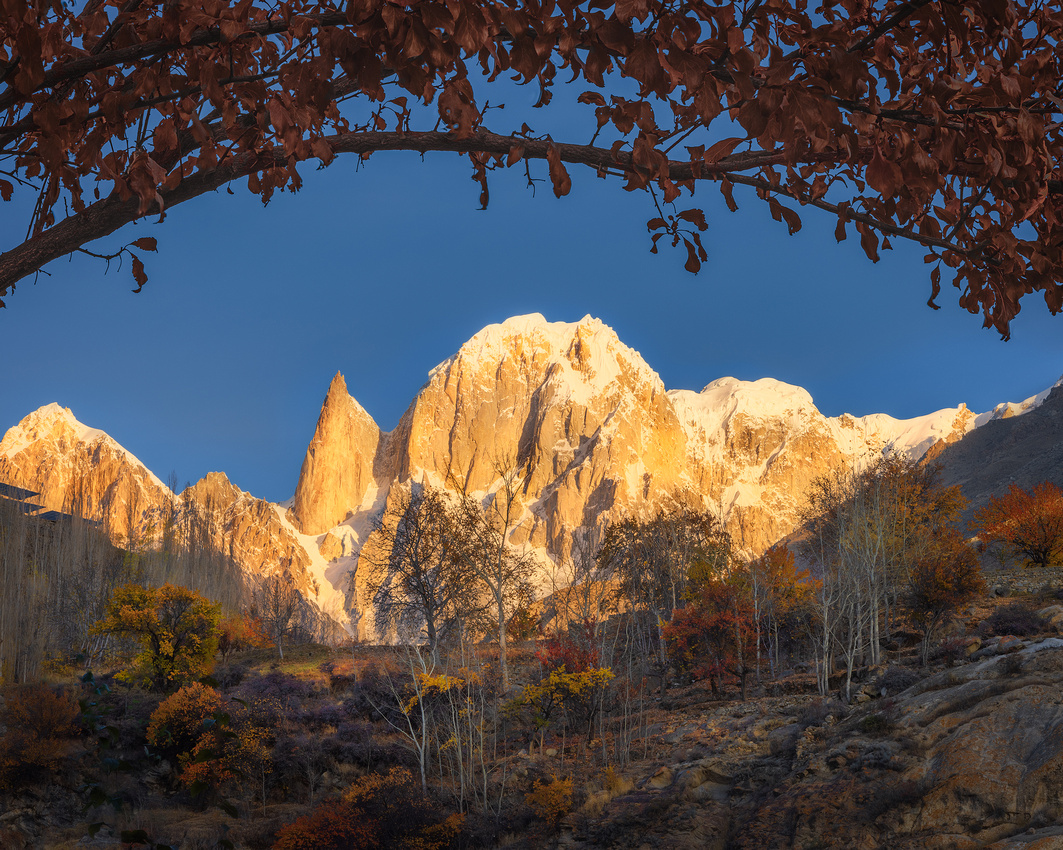

Ladyfinger Peak (also known as Bublimotin, Bubli Motin, or Bublimating) is a distinctive rock spire. Located near the city of Gilgit in the westernmost part of Pakistan’s towering Karakoram Mountain range, it stands tall as a lone sentry amidst the gorgeous embrace of the Hunza Valley.
The Peak is a sharp, relatively snowless rock spire that climbs to a dizzying height of 20,000 feet. The last 1,830 feet to the top are nearly vertical.
Ladyfinger is climbed mostly by alpinists, not mountaineers. Alpinism is a specialized form of climbing that focuses on ascending difficult routes in cold and challenging environments. It’s much more demanding, dangerous, and deadly than mountaineering.
Very few alpinists attempt Lady Finger. It’s one of the more difficult climbs in the area. The final 1,830 feet of sheer rock wall are extremely challenging. Those who succeed often paraglide back to the valley.
The Lady in Waiting
Legend has it that Kisar, a magical prince from Baltistan, came to the Hunza Valley on one of his adventures. While there, the already married prince met and married a princess named Bubli. Afterwards, Kisar learned that his first wife had been kidnapped. He promptly prepared to set off and rescue her.
Taking Bubli up the mountain that would later bear her name, he handed her a sack of grain and a chicken. Bubli asked him whether and when he would return. Kisar told her, "Every year give this chicken a single grain to eat. When the sack is empty, I will return. Until that time, stay here."
He left and they say Bubli is still waiting on Ladyfinger Peak.
The Shot
We left early on the morning of November 7 for our Ladyfinger photoshoot. Arriving well before sunrise, we had plenty of time to evaluate possible compositions. The Peak was about 5.5 miles away in the distance.
When I first saw it, I instinctively grabbed a shot. But the easiest photo is oftentimes the most boring photograph you can create. And that was the case this morning. What could be changed to make a more visually appealing image?
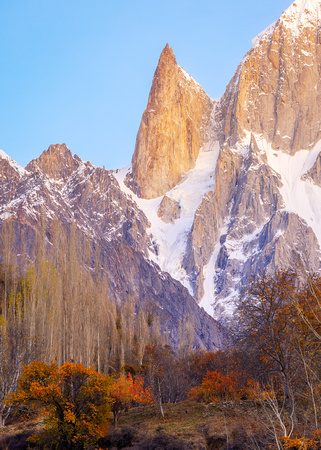

Boring!!!
Every time we take a photograph, we frame our subject. But frames within that frame potentially create striking and powerful images. Careful use of framing can help lead the viewer’s eye through the image and hold their interest much longer.
Luckily, there were several potential compositions that framed Ladyfinger. You’ll see more than one Friday Photo featuring Ladyfinger in a frame.
This framing composition excited me the most. Getting down on my stomach with my camera inches from the ground, an overhead arch of branches and leaves framed the top of the image. Ladyfinger is in the left center, with nearby Hunza Peak at 20,570 feet on the right.
Thanks for looking,
Chuck Derus
The Frozen Desert
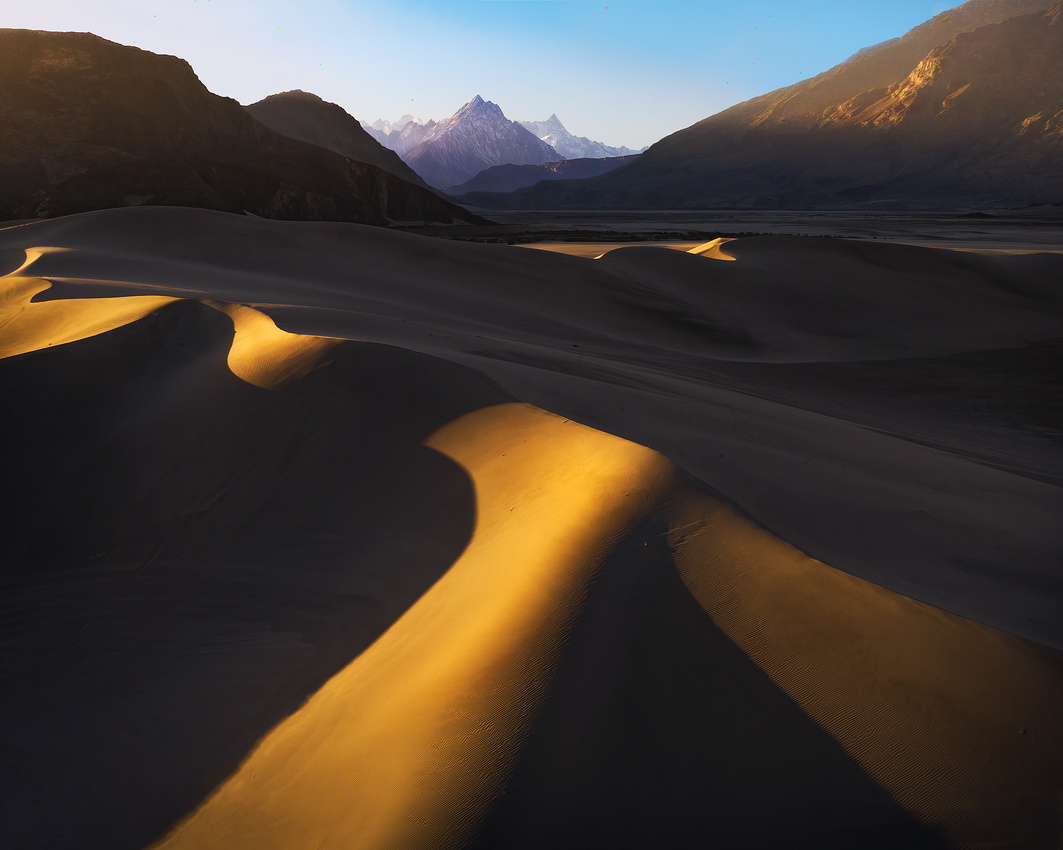

Hot comes to mind when you hear the word desert. But imagine a bizarre landscape of sand dunes, mountains, and extremely cold temperatures.
Welcome to a desert in Pakistan where biting cold dominates the landscape. At 7,500 feet above sea level, you’re in the Sarfaranga Desert, also called the Sarfaranga Cold Desert.
Located in the Shigar Valley near the town of Skardu, this desert displays immense diversity. The Indus River flows nearby. Towering mountains encircle the desert, with their greyish-black hues providing a dramatic backdrop that contrasts with endless golden sand fields. Sinuous, sensual dune shapes are everywhere. Ever-present strong winds create a magical atmosphere of dust and sand in the air.


Flying into Skardu in the Shigar Valley gave us our first taste of the sheer mountains in the area. You don’t gradually descend into the Skardu airport; you corkscrew your way down to the ground.
Our group leader somehow talked his way into a cockpit jump seat ride to Skardu. Arriving over Skardu, the pilot put the plane into a tight spiraling descent to the airfield, with the cockpit warning system blaring “Terrain!” repeatedly until the plane landed.
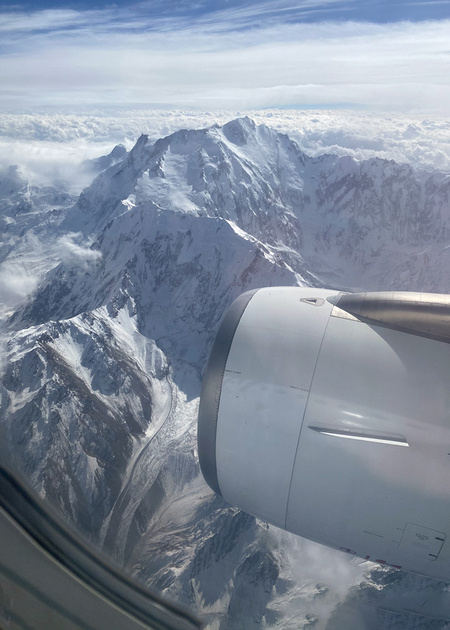

The view out my window near Skardu. Our cruising altitude isn’t much higher than the mountains!
The best time to visit the Sarfaranga Desert is from June to September when temperatures range between 46 and 75 degrees. The temperature can drop as low as 1 degree above zero between October and May. Luckily, we had a mild afternoon day in the 30s when I was there.
The Shot
On the afternoon of November 4, our photography group turned off the main road from Skardu and into the Sarfaranga Desert. Because the mountains are so high, sunset was going to occur at least an hour early when the sun dipped below the mountains.
I launched my drone with a wide-angle lens and pulled out my big camera with a telephoto lens. It turned out that one camera couldn’t capture the magic of what my eye was seeing.
I used a photo from each camera to create a focal length blend. Blending the wide-angle drone photo of the foreground dunes with the distant telephoto view of the mountains allows viewers “to be there” and experience what I saw.
Thanks for looking,
Chuck Derus